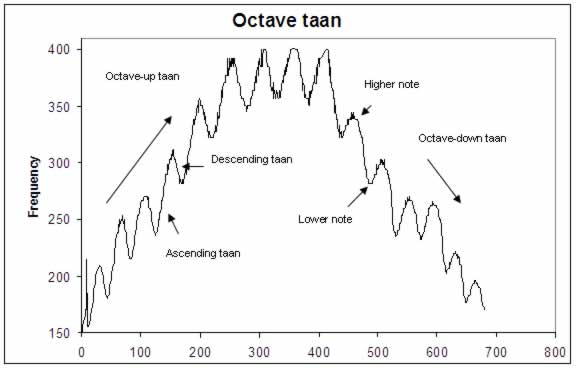
Acoustic, Aerodynamic, and Kinematic Description of “Taan” Gestures in Indian Classical Singing
Nandhakumar Radhakrishnan & Ronald C. Scherer,
200, Student Health Center, Dept. CDIS, Bowling Green State University,
Bowling Green, Ohio, USA 43402.
Email: nandhak@bgnet.bgsu.edu, ronalds@bgnet.bgsu.edu, Ph: 419-372-7189
Introduction:
The two major divisions in Indian classical music, the North Indian, or Hindustani,
and South Indian, or Carnatic, require extensive training and are considered
sacred. We studied the vocal physiology of an Indian classical singer during
“taan” production, an important aspect of ornamentation (like vibrato,
trill, and trillo) in the North Indian style of vocal music. Taan is a melodic
embellishment consisting of asymmetric rapid pitch rise and fall, the rate of
which can be varied by the singer.
Methodology:
• A 44 year old male, well-known Hindustani professional classical singer
was the subject. Acoustic, kinematic (EGG), and airflow signals were recorded
when the singer produced taan gestures while seated in a sound treated booth.
• Each local rise then fall of the Fo contour was defined as a “taan
gesture.” A series of taan gestures was produced during constant pitch
and during an octave increase and decrease.
Results and Discussion:
a. Taan produced while singing a constant pitch:
(i) Acoustic: Average frequency extent: 1.87 ST (0.34 SD). Average frequency
rate: 3.41
Hz (0.36 Hz SD).
(ii) Kinematic: Within-taan frequency increase resulted in an increase in EGGW
(i.e.,
greater adduction for higher frequencies.)
(iii) Airflow: For most of the taan gestures, the AC flow decreased with increase
in pitch.
OQ decreased with an increase in frequency.
b. Taan produced while singing octaves:
(i) Acoustic: On average, the number of semitones on the ascending side of the
octave-up of each taan gesture was 4.00 semitones, and 1.55 semitones on the
descending side. On the octave-down side there were 3.31 and 1.94 semitones
on the descending and ascending sides, respectively. Within the taan gestures,
when the frequency was lower-higher-lower, the intensity was usually higher-lower-higher,
an inverse relationship.
(ii) Kinematic: EGGW adduction measures increased with within-taan pitch rise,
suggesting an increase in vocal fold adduction.
(iii) Airflow: The glottal AC flow measures did not indicate a trend with pitch.
(iv) DC shifting: Based on the DC shifting behavior of the flow waveform,
the larynx
was estimated to rise and fall by approximately 1 cm.
Conclusion:
“Taan gestures” by the professional singer-subject appears to be
characterized by control via glottal adduction and wide pitch fluctuations.
The asymmetric frequency modulation appears to be controlled voluntarily, unlike
vibrato. The rate of taan of 3.41 Hz is slower than vibrato, trillo, or trill.
The extent of 1.89 ST is wider than vibrato but similar to trillo and trill.
During taan, this subject appeared to increase and maintain a relatively high
glottal adduction, perhaps to maintain a consistent timbre. The AC flow varied
with Fo for the taan gestures produced while singing a “constant pitch”,
but did not vary with Fo for the octave scales. It is hypothesized that a continuous
change in laryngeal height (a 1 cm rise and fall) created a pumping action of
the flow and contributed to the DC shift of flow and the modulated EGG waveform
during the octave scales.
Averages from literature and current study
| Taan | Vibrato | Trillo | Trill | |
| Extent (Semitones) | 1.9 | 1-2 | 2 | 2.7 |
| Rate (Hz) | 3.4 | 5-7 | 9 | 6.5 |

